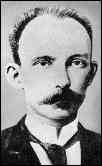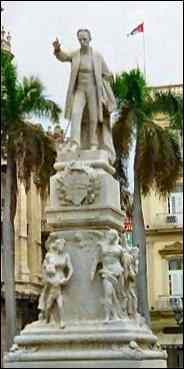

March 21. Martí is appointed professor in Caracas.
July 1. The first issue of Revista Venezolana, edited by Martí, is published.
July. A dispute with dictator Guzman Blanco forces Martí to leave Venezuela.
July 28. José Martí departs for New York, where he lives until 1895.
August 20. From NY, Martí begins to send articles to the newspaper La Opinión Nacional of Caracas.
December 1. U.S. Secretary of State James G. Blaine writes; “that rich island, the key to the Gulf of Mexico, and the field for our most extended trade in the Western Hemisphere, is, though in the hands of Spain, a part of the American commercial system… If ever ceasing to be Spanish, Cuba must necessarily become American and not fall under any other European domination.”
April. “Ismaelillo,” a book of poems by Martí about his son, is published. Martí also writes most of “Versos Libres” (Free Verses) but it remains unpublished.
September 13. Martí's article is published in La Nación of Buenos Aires.
November. Maceo receives the first letter from Martí, (dated July 20).
January. Appointed NY correspondent of “La Sociedad Amigos del Saber” of Caracas.
October 10. Delivers a speech commemorating the Grito de Yara (October 10, 1868).
October 20. In a letter to Gómez, Martí resigns from the revolutionary movement.
Publishes the novel “Amistad Funesta” under the pseudonym, Adelaida Ral, in El Latino-Americano of New York.
Becomes a correspondent for La República, in Honduras.
April 16. Appointed Uruguayan Consul.
April. Visited by his mother in New York.
February. Works on the translation of the poem by Thomas Moore, “Lala Rookh.”
Appointed corresponding member of the Academy of Sciences and arts of San Salvador.
October 12. Martí becomes a representative in the U.S. and Canada of the association La Prensa of Buenos Aires.
March 21. The New York Evening Post publishes a letter from Martí, “Vindication of Cuba.” This is later published as the booklet “Cuba and the United States.”

Martí is invited to become correspondent of El Partido Liberal de Mexico.
April 18. Sends first article to La Opinión Pública, of Uruguay.
July. The first issue of La Edad de Oro (The Golden Age) is published. (This is a monthly publication dedicated to the children of America.)
November 2. Martí’s article, published in La Nación (Buenos Aires) warns Latin America that the Pan-American Congress represents a move by pro-expansionist forces in the U.S. to dominate Latin America politically and economically.
November 20. Speaks at a meeting in Hardman Hall, in honor of the poet José María Heredia.
December 19. Speaks at a meeting of the Spanish-American Literary Society of New York.
January 22. Inauguration of The League, a society to promote education in New York. Martí becomes a teacher for Negro workers.
June 16. Appointed Argentine Consul in New York.
July 24. Appointed Paraguayan Consul in New York.
November. At a speech in Tampa, Martí states: “To all Cubans, whether they come from the continent where the sun scorches the skin or from countries where the light is gentler, this will be the revolution in which all Cubans, regardless of color, will participate.”
December 23. Appointed Uruguayan representative to International Monetary Conference in Washington.
December. Appointed chairman of the Spanish-American Literary Society of New York.
April. Speaks at a meeting of the Spanish-American Literary Society in honor of Mexico.
June. Speaks at a meeting organized by the Spanish-American Literary Society in honor of the Central American Republics.
June. “Versos Sencillos” (Simple Verses) is published.
October 11. Resigns as consul of Argentina and Uruguay.
October 30. Resigns post as chairman of the Spanish-American Literary Society.
November 25. Visits Tampa at the invitation of the “Ignacio Agramonte Club.”
November 27. Speaks at the Cuban Convention of Tampa. Founds the League for Education in Tampa (similar to The League in New York). Joins the Patriotic Cuban League.
November 28. Martí’s resolutions, considered the preamble to the bases of the Cuban Revolutionary Party, are approved.
December 25. At the invitation of a group of Cuban workers, Martí visits Key West.
January 3. Speaks at a meeting organized by the “San Carlos Club.”
January 4. Attends a meeting of the club “Patria y Libertad” (Homeland and Freedom).

January 5. After two years of organizing Cubans both inside and outside the island, José Martí founds the Cuban Revolutionary Party. This is quite an accomplishment, since he is able to unify many traditionally-conflicting interests behind the goal of Cuban independence.
January 8. Submits a program of the Cuban Revolutionary Party to the Tampa Patriotic League. The program is unanimously approved.
January 21. The League of New York holds a meeting protesting a letter in which Collazo and Roa slander Martí.
March 4. Martí launches PATRIA (Fatherland) a publication dedicated to the cause of Cuban independence. Tobacco workers in Florida donate most of the expenses for the first issue, which is edited by Puerto Rican Negro Sotero Figueroa.
March 5. In Mexico City, the newspaper El Partido Liberal publishes Martí's Our America.
“In Cuba,” Martí writes, “there is no fear of a racial war. Men are more than white, more than mulatto, more than black. They died for Cuba in the fields of battle; the souls of blacks and whites have risen together up to heaven. In daily life, in defense, in loyalty, in brotherhood, in study, at the side of every white there was always a black.”
April 18. Elected delegate of the Cuban Revolutionary Party.
July. Tours Florida to organize support for the Cuban Revolutionary Party.
August 4. Gives instructions to Major Gerardo Castellanos, first commissioner of the Cuban Revolutionary Party, who is about to leave for Cuba.
September 4. Leaves for Santo Domingo.
September 11. Meets with Máximo Gómez at La Reforma, in Santo Domingo, and invites him to participate on the movement for Cuban independence.
September 24 – October 13. Visits Haiti and Jamaica.
October 23. At a meeting of The League in New York, Martí talks about the tour he just completed.
November. Martí visits Tampa and Key West. A plot to poison him in Tampa fails.
December. Speaks at a meeting of the Spanish-American Literary Society of New York in honor of Venezuela.
José Martí Timeline - 1 | 2 | 3 |
José Martí Portal | Martí/Apostle | Books | Photos
Letters and Articles by José Martí
Our America |
Montecristi Manifesto (full text)|
Last letter to his mother | Incomplete
letter to his friend Manuel Mercado |
On
Antonio
Maceo | Letter to Maximo Gomez,
1884 (in which he resigns from the revolutionary movement) |
My Race (from Patria)
Thanks to Lina Garcia for the photo of the Martí statue in Havana